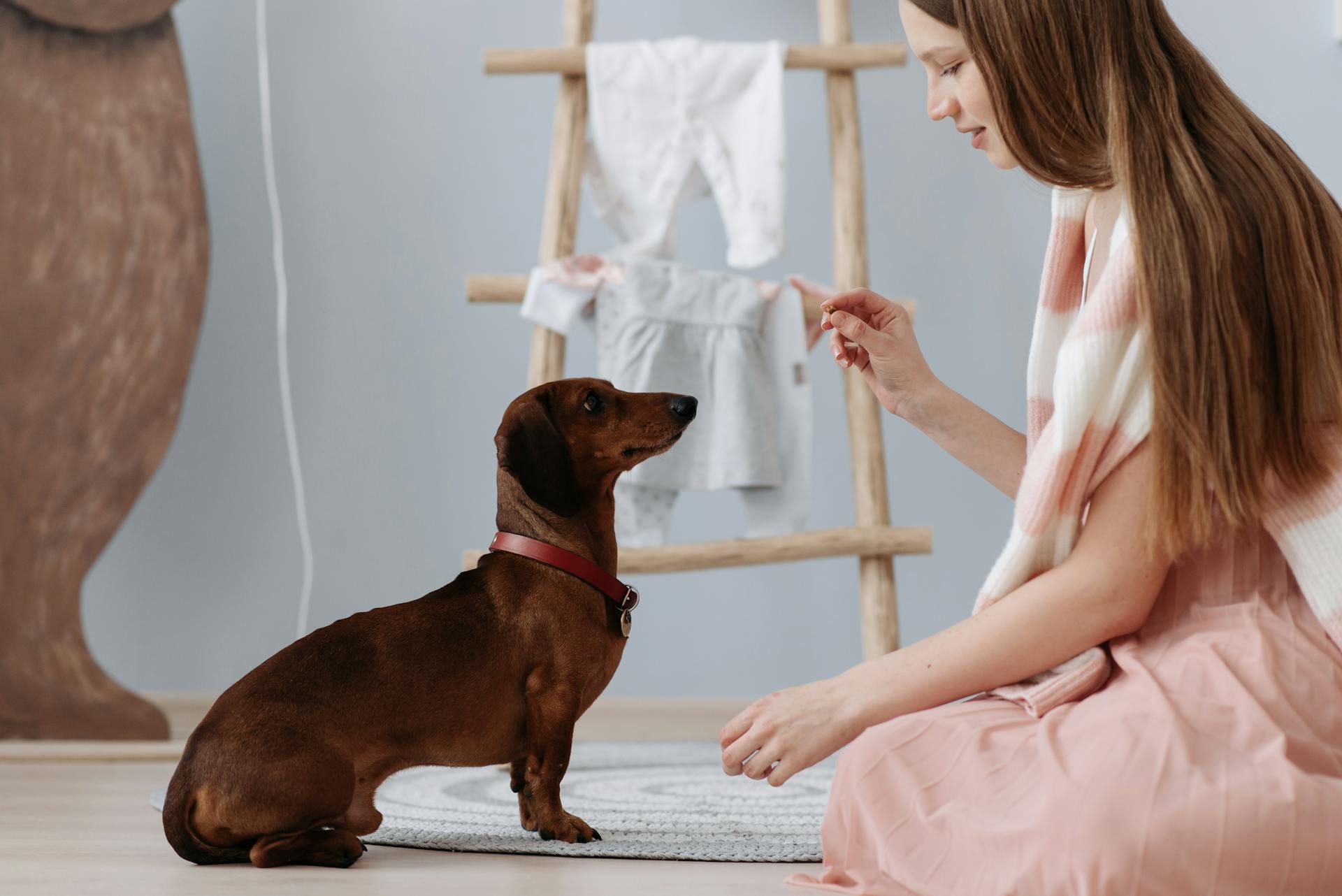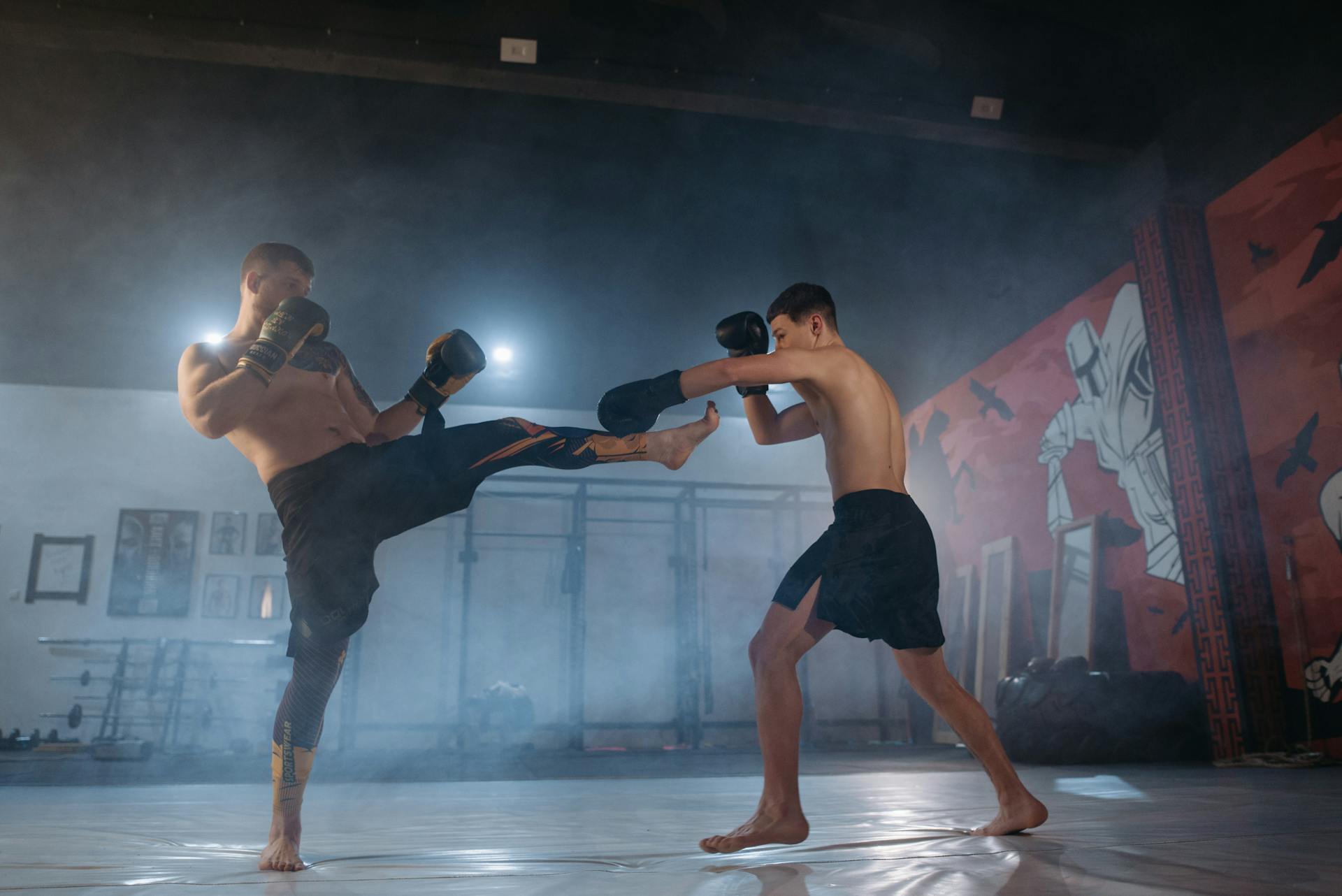
If you're new to dog training, it can be overwhelming to know where to start. One thing to keep in mind is that consistency is key, as seen in the article "Housebreaking 101", which emphasizes the importance of establishing a routine for feeding, exercise, and potty breaks.
Dogs thrive on predictability, and a consistent schedule helps them feel secure and in control. For example, the article "Basic Obedience Commands" highlights the value of using positive reinforcement techniques, such as treats and praise, to encourage good behavior.
Housebreaking can be a challenge, but with patience and persistence, you can help your dog learn to eliminate outside. According to the article "Housebreaking 101", accidents are a normal part of the learning process, and it's essential to clean up thoroughly after each incident to prevent your dog from being attracted to the same spot again.
Readers also liked: Step by Step Dog Training
Learning Theories
Observational learning is a powerful way dogs learn from others, and it doesn't require reinforcement to occur. A model animal is all that's needed to inspire learning.
Dogs are social creatures, and their social dependency makes them aware of the behavior of others, which contributes to their own behavior and learning abilities. They can learn by interacting with each other and with people.
A 2001 study showed that dogs can rely on information provided by human action when confronted with a new task. They may not copy the exact path of the human demonstrator, but adopt the detour behavior shown by humans to reach their goal.
Observational learning requires four necessary conditions: attention, retention, motivation, and production. This means the dog must pay attention to the modelled behavior, retain the information gathered, be motivated to reproduce the behavior, and finally, produce the behavior itself.
Puppies as young as 9-12 weeks can learn from observing their mothers at work, and this can improve their learning abilities later on. For example, pups who watched their mothers detect narcotics were more capable of learning the same skills at six months of age.
Operant conditioning is another way dogs learn, and it's based on cause-and-effect relationships. Behaviors are encouraged through reinforcement and discouraged through punishment.
In operant conditioning, reinforcement increases the probability of a behavior, while punishment decreases it. Positive reinforcement occurs when a behavior is strengthened by producing a desirable consequence, and negative reinforcement occurs when a behavior is strengthened by avoiding an undesirable consequence.
Suggestion: Caesar Millan Better Human Better Dog
Classical conditioning is a type of learning where a neutral stimulus becomes associated with an unconditioned response. This process was discovered by Ivan Pavlov, who found that dogs would salivate at the sound of a bell, even when no food was present.
In dog training, classical conditioning can be used to associate a command word with a behavior, such as sitting. This is done by repeating the command and rewarding the desired behavior.
You might like: Classical Conditioning Dog Training
Non-Associative Learning
Non-associative learning is a fascinating topic that can help us understand how our furry friends learn and adapt to their environment.
Habituation is a type of non-associative learning where a dog becomes less reactive to a stimulus after repeated exposure. For example, a dog that reacts excitedly to a doorbell may eventually stop reacting if the bell is rung repeatedly without any visitors arriving.
Sensitization, on the other hand, is when a dog becomes more reactive to a stimulus after repeated exposure. This can be seen in some dogs that become more aggressive or fearful in response to certain stimuli.
Learned irrelevance occurs when a dog learns that a cue or stimulus is irrelevant because it has been consistently exposed to it without any consequence. For instance, a dog owner who repeatedly says "Sit, sit" without rewarding or punishing the dog may inadvertently teach the dog to ignore the cue.
Consistent exposure to a feared object or situation can help desensitize a dog to its anxiety. This process involves pairing the feared object with positive experiences, allowing the dog to become less stressed over time.
Explore further: No Treat Dog Training
Observational Learning
Observational learning is a powerful way dogs learn, and it doesn't require reinforcement. They simply need to observe a model animal.
Dogs are social creatures, and their social dependency makes them aware of the behavior of others, which contributes to their own behavior and learning abilities. This is evident in the way puppies follow or copy others of their kind.
Observational learning encompasses several concepts, including allelomimetic behavior, social facilitation, and local enhancement. These terms describe how dogs learn from each other and their environment.
Here's an interesting read: Social Anxiety Dog Training
Four necessary conditions for observational learning are attention, retention, motivation, and production. This means a dog must pay attention to the model, retain the information, be motivated to reproduce the behavior, and finally, produce the behavior.
Puppies as young as 9-12 weeks can learn from observing their mothers, and this can significantly improve their learning abilities later on. In fact, a study found that pups who observed their narcotics-detecting mothers at work were more capable at learning the same skills at six months of age.
Dogs are also able to rely on information provided by human action when confronted with a new task. In one experiment, the demonstration of a detour by humans significantly improved the dogs' performance in trials, and they adopted the detour behavior shown by humans to reach their goal.
This type of learning is not limited to dogs learning from each other; they can also learn from humans. In an experiment, puppies who watched other puppies learn to pull a food cart into their cages by an attached ribbon proved considerably faster at the task when later given the opportunity themselves.
Classic Conditioning
Classic conditioning is a type of learning where a neutral stimulus is associated with an unconditioned response, turning the neutral stimulus into a conditioned stimulus.
This process was first discovered by Russian scientist Ivan Petrovich Pavlov in 1927 while studying dogs' digestive systems.
Pavlov's accidental finding involved an automatic feeding system that rang a bell before dispensing food, initially making the dogs anticipate the food but only salivating when it was present.
With time and repetition, the dogs started salivating at the sound of the bell even when no food was coming, demonstrating a conditioned response.
The sound of the bell produced the same physiological response as the food itself, making the dogs feel the same way the food did.
In obedience training, classic conditioning is used to associate a command word like 'sit' with the behavior of sitting, resulting in the dog responding correctly to a signal.
The understanding of classic conditioning has significant implications for training and learning, making it a crucial concept to grasp.
Here's an interesting read: Training Dog to Ring Bell to Go Out
Training Methods
The Koehler method uses punishment and negative reinforcement to train dogs, but some trainers now consider these methods inhumane. Positive reinforcement, on the other hand, is a more humane approach that uses rewards to encourage desired behavior.
Positive reinforcement training is also known as humane training, force-free training, and reward-based training. It's based on Thorndike's law of effect, which states that actions that produce rewards tend to increase in frequency. All animals used for commercials, TV shows, and movies are trained with positive reinforcement.
Relationship-based training is built upon the ideas of symbolic interactionism, focusing on the ways dogs and their trainers communicate and understand each other. This approach sets out to achieve results that benefit both the dog and the trainer, while enhancing and strengthening their relationship.
A fresh viewpoint: Dog Obedience Classes and Trainers for Well-behaved Pets Scottsdale
Getting Started in Sports
If you're new to dog sports, it's essential to start with the basics.
You can begin by introducing your dog to dog sports through the "Intro to Dog Sports" section, which provides a solid foundation for your journey.

To get started, you can enroll your mixed-breed dog in a canine partners program, which is available for mixed breeds.
Understanding dog sport titles and abbreviations is crucial, so be sure to check out the "Titles & Abbreviations" section for clarification.
Consider your dog's breed and personality when deciding which sport to participate in, as some sports may be more suitable than others. The "Which Sport Should You Do With Your Dog?" section can help you make an informed decision.
To begin training, start with the basics by following the steps outlined in the "Get Started in Dog Training" section.
If you're interested in virtual dog sports and events, be sure to check out the "Virtual Dog Sports & Events" section for more information.
Consider reading: Virtual Dog Training
Operant Conditioning
Operant conditioning is a type of learning in which an individual's behavior is modified by its consequences. This form of learning is based on the idea that behavior is influenced by its effects, rather than just by instinct or genetics.
There are four ways to modify behavior through operant conditioning: positive reinforcement, negative reinforcement, positive punishment, and negative punishment. Positive reinforcement occurs when a behavior is strengthened by producing a desirable consequence, such as a reward or praise.
Negative reinforcement, on the other hand, occurs when a behavior is strengthened by avoiding an undesirable consequence, such as a punishment or a threat. Positive punishment is when a behavior is weakened by producing a consequence that is a disincentive, such as a scolding or a time-out. Negative punishment is when a behavior is weakened by removing a reinforcing consequence, such as a toy or a treat.
The Quadrant, a framework used in operant conditioning, illustrates the different combinations of positive and negative reinforcement and punishment. It shows that positive reinforcement and punishment can be used to increase or decrease behavior, while negative reinforcement and punishment can be used to increase or decrease behavior as well.
Here's a summary of the four ways to modify behavior through operant conditioning:
In operant conditioning, timing is everything. The reward must occur immediately after the desired behavior, or the dog may not associate it with the proper action. Consistency is also key, as everyone in the family should use the same cues to avoid confusion.
Dominance-Based
Dominance-Based training methods focus on establishing a clear hierarchy within the pack, with the trainer as the dominant leader. This approach is rooted in the idea that wolves establish dominance through assertive behavior.
In a dominance-based pack, the alpha dog leads the way and the others follow. The alpha's dominance is not about aggression, but about calm, assertive leadership.
This style of training can be effective in establishing clear boundaries and expectations, but it requires a strong, confident trainer who can assert their authority without being aggressive.
If the trainer is not confident or assertive, the pack may not respect their leadership, leading to confusion and potential behavioral problems.
In a dominance-based pack, the trainer should reward desired behavior and calmly address undesired behavior, using body language and vocal cues to reinforce their leadership.
Consistency is key in dominance-based training, as the pack needs to understand and respect the trainer's authority.
For another approach, see: Canine Dominance Behavior
Individualized or Class
Individualized training allows a trainer to focus on a dog's unique abilities and needs, as well as address specific owner preferences and circumstances.
One-to-one training is especially helpful for addressing behaviour problems, which are best tackled by a dog behaviourist.
Class training, on the other hand, can be effective in encouraging socialization and play with a peer group.
Classes often offer a more affordable rate and can cover both problem behaviours and teach new skills.
Classes can range from puppy and beginner training to more advanced training and skill training, such as preparing for dog sports like agility or flyball.
Sources
Featured Images: pexels.com


